[ensemblevideo version=”5.6.0″ content_type=”video” id=”d51964aa-1141-4aa8-b7c0-0d714edf08d7″ width=”848″ height=”480″ displaytitle=”true” autoplay=”false” showcaptions=”false” hidecontrols=”true” displaysharing=”false” displaycaptionsearch=”true” displayattachments=”true” audiopreviewimage=”true” isaudio=”false” displaylinks=”true” displaymetadata=”false” displaydateproduced=”true” displayembedcode=”false” displaydownloadicon=”false” displayviewersreport=”false” embedasthumbnail=”false” displayaxdxs=”false” embedtype=”responsive” forceembedtype=”false” name=”Influence of Tourism on Local Communities in the Bristol Bay Watershed, Alaska – Manuela Velasquez”]
Here you can learn more about the influence of tourism on local communities in the Bristol Bay watershed, Alaska with a student video presentation by me, Manuela Velasquez. This may seem like a pretty specific, small regional area to dive into when you’re still learning about the Arctic as a whole; however, engaging with localized issues is crucial for understanding broader themes in Arctic politics and for contextualizing the regional diversity of issues that different countries, states, and peoples deal with.
This video dives into the prominence of salmon in Bristol Bay as the lifeblood of sustenance fishing practices of Indigenous peoples in the area, a huge commercial fishing industry, and a recreational sport fishing industry in the watershed (re: tourist industry). Maybe you’ve heard of Bristol Bay as the proposed regional site for Pebble Mine, a controversial copper mine development that could poison the region’s ecosystems, communities, and industry. This video offers a foundational grasp of Bristol Bay’s industries and stakeholders, then contextualizes their contemporary relevance with Pebble Mine.
In my video, I discuss the economic relevance of each of these fishing activities in the region, particularly the economic importance of commercial fishing and recreational fishing. You might be wondering: how are those two forms of fishing different when the end result is the same: salmon are extracted from the region? It turns out that most Indigenous residents of the region work for the commercial fishing industry and are able to time their work/payoff in seasonal commercial fishing with the schedule of their important sustenance fishing practices. An issue with tourists fishing recreationally, however, is that many boats travel up rivers in the Bristol Bay watershed, away from the bay itself where much commercial fishing is done — this encroaches upon and even damages areas where Indigenous community members normally practice sustenance fishing.
Tourism can help with generating non-local and even international sentiments of responsibility for protecting the region, however. We see this in advocacy against the development of Pebble Mine — recreational sport fishing has given many more people around the world a personal stake in the wellbeing of Bristol Bay, its people, and its fish.
